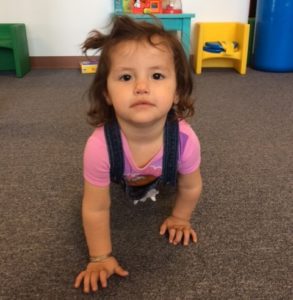The Benefits of Crawling (Before Walking)
By Nikki Robinett, PT, DPT and Amanda Bruce, OTR/L
AZOPT Kids Place Central Therapists
In the ever changing world of pediatrics, where new evidence and opinions are constantly telling us what our children should (or should not) be doing, parents can be understandably confused. One recent discussion revolves around the importance and benefits of crawling. As therapists who treat babies every day, we hear this debate regularly. While many views may differ, we believe it is most beneficial to encourage your little one to crawl as soon as possible or at least before walking. Here’s why:
Shoulder stability
Weight bearing on upper extremities aids in the development of shoulder girdle strength and endurance. It is known through research that stability closer to the core will lead to greater mobility and use of smaller muscle groups farther from the core. A strong shoulder system will assist in the development of stronger fine motor skills, endurance for upper extremity tasks, postural control, and increased self-care skills.
Balance
A wonderful benefit of crawling is the amount of muscles required to get into a crawling position and maintain this position while mobile. Not only does this require wrist, hand, arm and leg strength, but it also builds head control. Further, crawling helps develop core (abdominal) strength by keeping their tummies off the ground. When crawling, a baby may change directions due to an obstacle and use their obliques, on the outside of their abdominals. When they crawl over obstacles, they also use their hip flexors and hip abductors which are important endurance and stabilizing muscles for efficient and safe walking.
Reciprocal programming/Dissociation
It is also important for children to develop the ability to utilize one side of the body at a time or one muscle group at a time. This is called dissociation. It is important for a child to be able to utilize both sides of the body reciprocally, as this is a precursor to walking. Crawling with one leg, and one arm at a time, mimics the same pattern that an individual utilizes when they are walking.
Crossing Midline
A large part of bilateral coordination is the ability to cross midline. This requires dissociation of sides of the body, vestibular and proprioceptive awareness, and integrated reflexes. Crawling is when crossing midline begins. This will eventually develop into the ability to tie shoes, eat independently, fasten clothing, and perform many other day to day and coordination-based skills.
Development of Hand Arches
An efficient and appropriate grasping pattern (pencil, crayon, feeding utensil, etc.) is strongly influenced by the development of hand arches. These arches are developed through the use of hands in appropriate grasping patterns as well as weight bearing tasks. As the musculature within the hand develops, it is important that web-space between fingers/thumb and the palm are splayed and evenly receiving weight. Crawling is the perfect way to provide this weight bearing input!
Earlier Independence
A child who crawls independently will learn, at a younger age, how to navigate and explore their environment on their own. They may learn to pull up on their own, locate and experiment with new toys, and generally learn to meet their own needs (sensory, hunger, thirst, tired, etc.)
Sensory Input
Crawling provides a large variety of sensory input including tactile, proprioceptive and vestibular input. A child who engages with their environment will feel the various textures under their hands and legs as they crawl throughout a space. This will build their tolerance to various textures. The vestibular system recognizes movement, acceleration, and the position of the head in reference to the rest of the environment. Crawling provides movement input in all of these areas as a child must learn awareness of their head position, pace of movement, and directionality of their movement. For children who may require more movement input, crawling is a great start for them to begin providing this input to their own bodies! An individual’s proprioceptive system is the awareness of their body position (joints) in space. Signals are sent to this system from receptors within the joints. Weight bearing tasks such as crawling are one of the best ways to provide natural joint compression input to integrate this system. Additionally, core activation, which is required for crawling, can activate postural proprioceptive receptors as well.
Safety
One of the other benefits of crawling before walking is that your children will be safer navigating environments if they are closer to the floor. Children are less likely to fall, trip or hit their heads on objects if they are on hands and knees rather than unsteady on their feet. This is especially helpful if there are other obstacles, babies or pets also roaming around on the floor in addition to your child.








